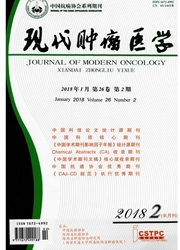

 中文摘要:
中文摘要:
目的:探讨NDRG2在热疗诱导的热应激抗肝癌细胞侵袭中所发挥的作用和机制研究。方法:构建NDRG2过表达和干涉表达的HepG-2细胞稳转细胞株,通过Transwell和Western-blot方法检测了和细胞侵袭力和细胞内NDRG2、MMP-2和MMP-9的表达量变化;构建荷瘤鼠模型,通过HE染色及免疫组化方法检测并对比了热对肿瘤细胞向周围肌肉组织的侵袭抑制作用。结果:给予NDRG2过表达的HepG-2细胞45℃、30min热处理后,细胞内NDRG2的表达明显增高,同时伴随细胞侵袭力、MMP-2和MMP-9的表达明显降低(P〈0.05)。与对照组相比,45℃的局部热作用能有效抑制肿瘤细胞对周围肌肉组织的侵袭,而干涉细胞内NDRG2的表达则降低了热对肿瘤细胞侵袭的抑制。对其机制的研究中发现,给予对照和NDRG2过表达的HepG-2细胞45℃,30min热刺激后,HSP70在热后6h表达量开始升高,而在两个组之间没有显著差异;对照组的HepG-2细胞在给予热处理后ERK1/2的磷酸化水平降低;NDRG2的过表达不仅降低了细胞中ERK1/2的本底水平,还降低了热作用早期对ERK1/2的诱导;进一步分别应用ERK1/2,p38MAPK和JNK三个激酶的抑制剂作用于NDRG2被敲除的HepG-2细胞,经过热处理后ERK1/2抑制剂组可以明显抑制HepG-2细胞的侵袭。结论:热应激所诱导NDRG2的表达量与肝癌细胞的侵袭力呈现一种负相关性;在热应激抗肝癌细胞侵袭的作用中,是通过影响NDRG2-ERK1/2通路而实现的。
 英文摘要:
英文摘要:
Objective: To investigate the function and mechanism of NDRG2 in hyperthermia (HT) induced heat stress retards invasion of hepatocellular carcainoma cells. Methods: We established the stable cell lines with NDRG2 overexpression or NDRG2 knockdown. Matrigel invasion assay and Western-blot were performed to evaluate the effect of heat stress on invasion of cells. We further established mouse xenograft model. H&E and immunohistochemical staining examined the anti-invasion potential. Results: In NDRG2 over expressing cells, HT at 45 ℃ reduced the invasive potential significantly, compared with HepG-2 cells treated by HT alone. We next detected the expression of MMP-2 and MMP-9. Western-blot revealed that expression of MMP-2 and MMP-9 decreased in NDRG2 overexpressing HepG-2 cells and even lower after the cells were treated by HT. Malignant tumors slightly invaded into nearby tissues in HT treated mouse model. In contrast, suppression of NDRG2 facilitate invasion of tumor nodules and reversed anti-invasive effect of liT in HepG-2 cells with significant destruction of the muscle layer as well as alleviated the repression of MMP-2 and MMP-9 expression by HT. To elucidate the molecular mechanism of NDRG2 mediated the anti-invasion effect of liT. We examined the expression of liSPs and MAPKs in HepG2 cells of control and overexpression of NDRG2 at different time points after cells were subjected to HT at 45 ℃ for 30 min. HSP70 expression was induced at 6h and kept at high levels after HT. However, the expression pattern of HSP70 was the same between these two groups. The phosphorylation of ERK1/2 declined after heat treatment. Moreover, overexpression of NDRG2 abrogated the intrinsic and HT induced activation of ERK1/2 pathway. The ERK1/2 inhibitor (PD98059) treatment could significantly enhance the anti-invasive effect of liT. Conclusions: The expression of NDRG2 and cell invasion ability are negative correlation. In addition, NDRG2 mediates the anti-invasion effect of hyperthermia via inhibition of
 同期刊论文项目
同期刊论文项目
 同项目期刊论文
同项目期刊论文
 期刊信息
期刊信息
